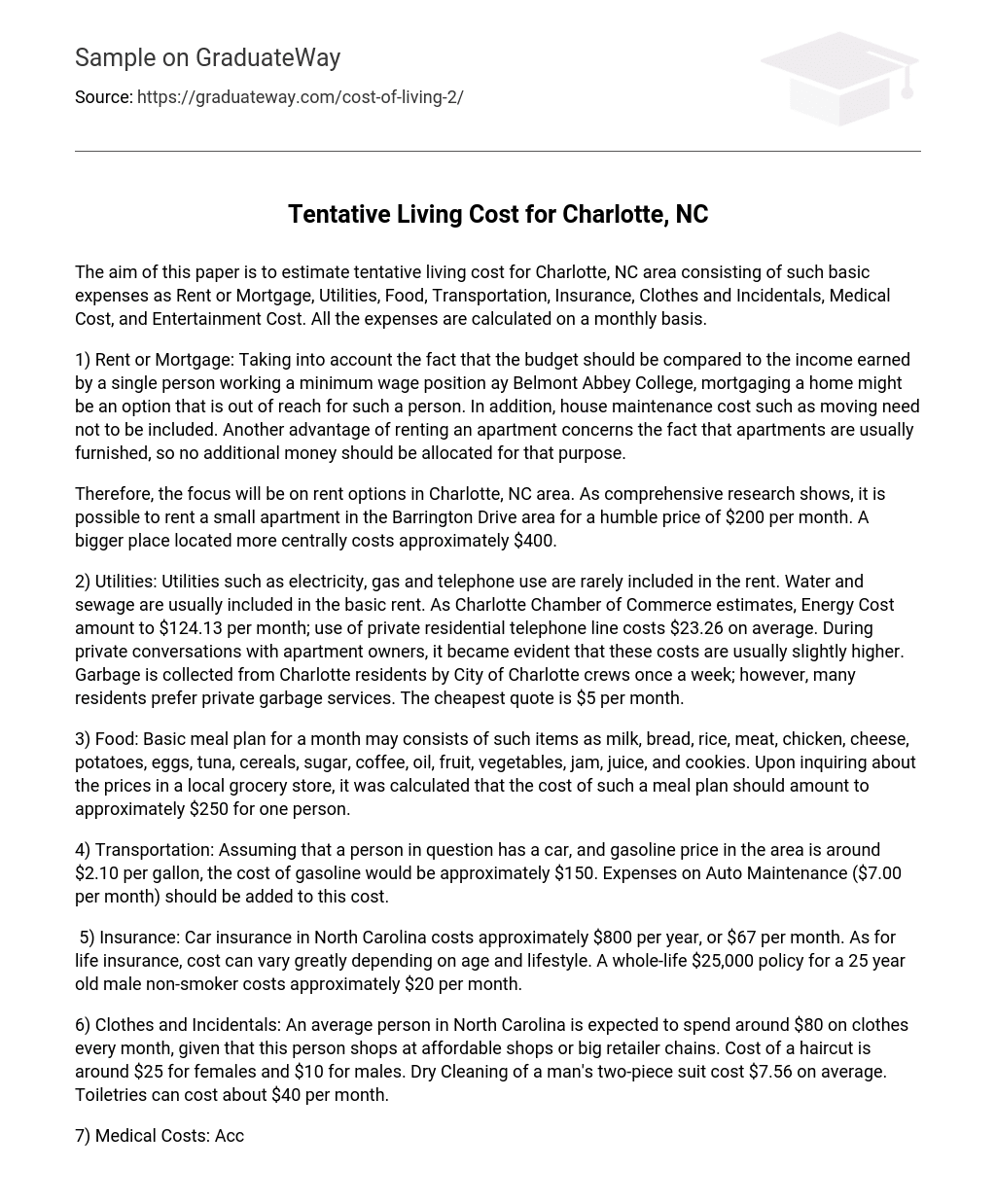The aim of this paper is to estimate tentative living cost for Charlotte, NC area consisting of such basic expenses as Rent or Mortgage, Utilities, Food, Transportation, Insurance, Clothes and Incidentals, Medical Cost, and Entertainment Cost. All the expenses are calculated on a monthly basis.
1) Rent or Mortgage: Taking into account the fact that the budget should be compared to the income earned by a single person working a minimum wage position ay Belmont Abbey College, mortgaging a home might be an option that is out of reach for such a person. In addition, house maintenance cost such as moving need not to be included. Another advantage of renting an apartment concerns the fact that apartments are usually furnished, so no additional money should be allocated for that purpose.
Therefore, the focus will be on rent options in Charlotte, NC area. As comprehensive research shows, it is possible to rent a small apartment in the Barrington Drive area for a humble price of $200 per month. A bigger place located more centrally costs approximately $400.
2) Utilities: Utilities such as electricity, gas and telephone use are rarely included in the rent. Water and sewage are usually included in the basic rent. As Charlotte Chamber of Commerce estimates, Energy Cost amount to $124.13 per month; use of private residential telephone line costs $23.26 on average. During private conversations with apartment owners, it became evident that these costs are usually slightly higher. Garbage is collected from Charlotte residents by City of Charlotte crews once a week; however, many residents prefer private garbage services. The cheapest quote is $5 per month.
3) Food: Basic meal plan for a month may consists of such items as milk, bread, rice, meat, chicken, cheese, potatoes, eggs, tuna, cereals, sugar, coffee, oil, fruit, vegetables, jam, juice, and cookies. Upon inquiring about the prices in a local grocery store, it was calculated that the cost of such a meal plan should amount to approximately $250 for one person.
4) Transportation: Assuming that a person in question has a car, and gasoline price in the area is around $2.10 per gallon, the cost of gasoline would be approximately $150. Expenses on Auto Maintenance ($7.00 per month) should be added to this cost.
5) Insurance: Car insurance in North Carolina costs approximately $800 per year, or $67 per month. As for life insurance, cost can vary greatly depending on age and lifestyle. A whole-life $25,000 policy for a 25 year old male non-smoker costs approximately $20 per month.
6) Clothes and Incidentals: An average person in North Carolina is expected to spend around $80 on clothes every month, given that this person shops at affordable shops or big retailer chains. Cost of a haircut is around $25 for females and $10 for males. Dry Cleaning of a man’s two-piece suit cost $7.56 on average. Toiletries can cost about $40 per month.
7) Medical Costs: According to the group health insurance plan, medical cost amounts to $47.25 plus the $20 co-pay for going to a primary care physician. Medical check up costs $74.40 on average, and $82.40 is to be paid for a dentist visit.
8) Entertainment Costs: As Charlotte Chamber of Commerce informs, pizza from Pizza Hut costs $8.98 on average, movie visit is $7.80, newspaper subscription with home delivery costs $13, and a six-pack of beer is $7.64.
Commentary: Total living cost per month is approximately $1.100 per month, or 13.200 per year. This means that a minimum wage is insufficient to cover basic living costs. While basic costs can be reduced by renting a room instead of apartment, or sharing an apartment with a roommate, or by using public transport instead of a private car, it is still very hard to make ends meet.
As Barbara Ehrenreich (2002, p.122) rightfully observes, more and more people find it increasingly hard to arrive at a ‘comfortable correspondence between income and rent.’ Affordable housing options are becoming scarcer every year, while living costs are soaring.
Those citizens who mange to ‘achieving a decent fit between income and expense’ (Ehrenreich, 2002, p.197) have to work seven days a week. In fact, in the wealthiest country in the world, employment does not guarantee prosperity. There are many citizens from a variety of backgrounds who are working hard but have no chance of becoming ‘social climbers.’ In fact, these citizens teeter on the lip of the abyss: any financial instability can result in quick descent into lower class. These citizens are rarely seen in the public arena. The main reason for that is the fact they are too busy struggling for survival to afford any kind of civil disobedience or protest.
It is more than evident that the problem of the working poor needs attention from the authorities and adequate policy responses.
References
Ehrenreich, Barbara. Nickel and Dimed: On (Not) Getting By in America. New York: Holt Paperbacks, 2002.





